|
Sword
Show 2003 - Orlando
By J. Clements
I had the pleasure of an invitation to this year's sword show in Orlando,
Florida, February 14th &15th. It was held at a Holiday Inn Resort
on International Drive, an area I know, being from Florida myself and
having lived in O'town for a while some years back. The purpose of the
event is to allow distributors to see the competing products of the major
off-the-shelf manufacturers all under one roof so they can make decisions
as to what they want to purchase for retail. I attended with Belinda Hertz
and my old friend, Fred Lehman. My interest was, as usual, only in the
Medieval and Renaissance European swords.
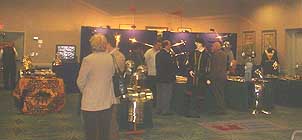 While
checking out this year's new pieces and studying changes to last years,
I mixed and mingled with Barry Ross, president of CAS Iberia and Jeff
Epperson, general manager of CAS Iberia, as well as Paul Chen of Hanwei
in mainland China, maker of CAS Iberia's primary line. Bruce Brookheart
chief designer from MRL was there to talk with as was MRL consultant Hank
Reinhardt. Lynne Thompson of Cold Steele attended, as did Bob Miller of
Pro Cut makers of the Valiant Armoury line and others produced in the
PI, and James Williams of Bugei was also on hand, as well as Deepeeka,
and Abs, Lic, Acero Toledano -a Spanish maker of decorative weapons from
Toledo. Also attending were United Cutlery and Gift International. It
would have been nice to see some of the other major sword industry manufacturers
there, especially the respectable Albion, but I understand the reasons
behind the combined attendance of these particular companies. I also talked
with some foreign sword buyers and assistants. While
checking out this year's new pieces and studying changes to last years,
I mixed and mingled with Barry Ross, president of CAS Iberia and Jeff
Epperson, general manager of CAS Iberia, as well as Paul Chen of Hanwei
in mainland China, maker of CAS Iberia's primary line. Bruce Brookheart
chief designer from MRL was there to talk with as was MRL consultant Hank
Reinhardt. Lynne Thompson of Cold Steele attended, as did Bob Miller of
Pro Cut makers of the Valiant Armoury line and others produced in the
PI, and James Williams of Bugei was also on hand, as well as Deepeeka,
and Abs, Lic, Acero Toledano -a Spanish maker of decorative weapons from
Toledo. Also attending were United Cutlery and Gift International. It
would have been nice to see some of the other major sword industry manufacturers
there, especially the respectable Albion, but I understand the reasons
behind the combined attendance of these particular companies. I also talked
with some foreign sword buyers and assistants.
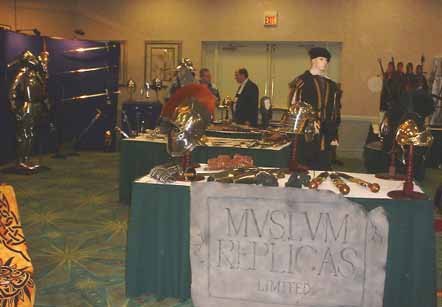 This
year's show was a bit larger than the last ones in Vegas and New Orleans,
but my overall impression was that there were fewer new swords on hand
than in the past. My viewpoint at these events is of course that of a
practitioner and spathologist (student of sword history) concerned with
the performance characteristics and accuracy of weapons for the community
of historical fencing martial artists. Any consultation or advice I offer
the industry comes from those perspectives. So, for my opinion to be valued
and my feedback welcomed is heartening and it's always good to hear the
"Ahhs" and "Ohhhs…" when useful information is
provided. Even better is to see results of previous suggestions or comments
actually reach beneficial fruition in products. What's disheartening is
to see decline in accuracy or quality and the results of decisions having
nothing to do with accuracy and performance of items. This
year's show was a bit larger than the last ones in Vegas and New Orleans,
but my overall impression was that there were fewer new swords on hand
than in the past. My viewpoint at these events is of course that of a
practitioner and spathologist (student of sword history) concerned with
the performance characteristics and accuracy of weapons for the community
of historical fencing martial artists. Any consultation or advice I offer
the industry comes from those perspectives. So, for my opinion to be valued
and my feedback welcomed is heartening and it's always good to hear the
"Ahhs" and "Ohhhs…" when useful information is
provided. Even better is to see results of previous suggestions or comments
actually reach beneficial fruition in products. What's disheartening is
to see decline in accuracy or quality and the results of decisions having
nothing to do with accuracy and performance of items.
I did find some really lovely pieces at this year's show, and a few dogs
as well. I won't make any comments here about "best of show"
or "worst of show" because this is not a commercial evaluation
of anyone's products, just observations on a few of the pieces I examined
and ARMA does not endorse any makes or models of swords. Whether or not
the characteristics I admired in any one sword will actually be maintained
in final production models available to consumers or are just exclusive
to the prototypes I handled, I can't say. From past experience I've learned
to be very conservative in my comments. Further, getting to examine and
heft some swords is hardly equivalent to working out with one, let alone
sparring or test cutting with it. So, I compare this event to visiting
an auto show. You get to look at the cars all shiny and new and read the
literature and watch the pretty models, you even get to sit in the car,
but you won't be allowed to test drive one.
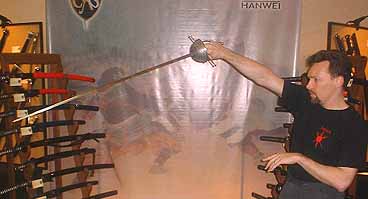 Of
the vendors, CAS Iberia, who has consistently improved in the last two
years, had some nice things. Although they did not have as wide a new
selection as some of the others, their wares continue to progress noticeably,
and they did have some good pieces, especially a very, very nice new cup-hilt
rapier that seems the best for the value I have run across so far. Of
the vendors, CAS Iberia, who has consistently improved in the last two
years, had some nice things. Although they did not have as wide a new
selection as some of the others, their wares continue to progress noticeably,
and they did have some good pieces, especially a very, very nice new cup-hilt
rapier that seems the best for the value I have run across so far.
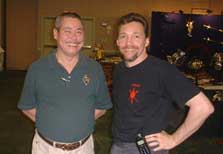 Chief
maker Paul Chen, a man who comes across as sincerely wanting to make the
best he can, was very proud of it and the blade was particularly rigid
and of good length. The hilt was not perfectly balanced and could be improved,
but the feel of the piece is just what we've been looking for in a rapier.
I can't wait to see how it is changed and I hope they follow through with
a foyled version for practice. Paul told me he had taken the dimensions
closely from an existing piece and, true to his sincere love of his craft,
was concerned for how accurate it was in the final. I noticed right away
that the point did not narrow enough and had an odd clipped shape for
a rapier. Chief
maker Paul Chen, a man who comes across as sincerely wanting to make the
best he can, was very proud of it and the blade was particularly rigid
and of good length. The hilt was not perfectly balanced and could be improved,
but the feel of the piece is just what we've been looking for in a rapier.
I can't wait to see how it is changed and I hope they follow through with
a foyled version for practice. Paul told me he had taken the dimensions
closely from an existing piece and, true to his sincere love of his craft,
was concerned for how accurate it was in the final. I noticed right away
that the point did not narrow enough and had an odd clipped shape for
a rapier.
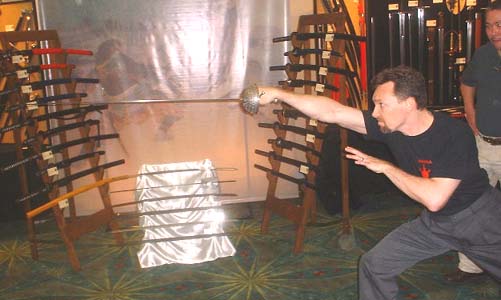 When
I commented on it Paul immediately said, yes, that the original was much
longer and thinner but that they had shortened this one because they could
not manage any way to draw it from the sheath (!). Hearing this I showed
Paul just how the rapier was worn and physically how it could be properly
drawn, even if quite long, and he was excited at the news, telling me
he would try now to make an even longer and more sharply pointed version
of this fine rapier. I really think Paul will be doing even better work
in the future. CAS Iberia has a lot of plans for many new items and products
that our community could greatly benefit from, including padded sparring
weapons and other gear. I hope the community gets the chance soon to see
their efforts, as this year their new offerings were sparse. When
I commented on it Paul immediately said, yes, that the original was much
longer and thinner but that they had shortened this one because they could
not manage any way to draw it from the sheath (!). Hearing this I showed
Paul just how the rapier was worn and physically how it could be properly
drawn, even if quite long, and he was excited at the news, telling me
he would try now to make an even longer and more sharply pointed version
of this fine rapier. I really think Paul will be doing even better work
in the future. CAS Iberia has a lot of plans for many new items and products
that our community could greatly benefit from, including padded sparring
weapons and other gear. I hope the community gets the chance soon to see
their efforts, as this year their new offerings were sparse.
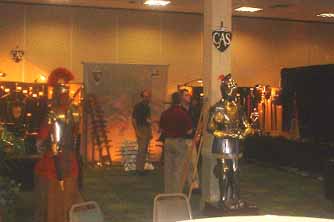 Cold
Steel had the most interesting set up, though not the most attractive,
as it offered a TV monitor playing Lynne Thompson's video of test cutting,
"Proof" and "More Proof". Huge slabs of beef and other
materials were sheared through effortlessly by various bowie knives, sabres,
katanas, and Medieval swords. I only paid attention to the Medieval swords.
As a fighter, I was trying not to notice the technical and tactical mistakes
of the cutting, but just the physical affects of the weapon on the target.
They were impressive, but without examining the blades used, both before
and after, for edge sharpness and blade distortion from striking bone,
it didn't tell me much about their product and certainly nothing new about
what swords can do. Their longswords and great swords seemed well made,
but I was not able to evaluate them except to say I think they need to
work on getting the weight right. From the quality of their knives and
other products, they hold a lot of promise and I would like sometime to
check their weapons out more intensely. Cold
Steel had the most interesting set up, though not the most attractive,
as it offered a TV monitor playing Lynne Thompson's video of test cutting,
"Proof" and "More Proof". Huge slabs of beef and other
materials were sheared through effortlessly by various bowie knives, sabres,
katanas, and Medieval swords. I only paid attention to the Medieval swords.
As a fighter, I was trying not to notice the technical and tactical mistakes
of the cutting, but just the physical affects of the weapon on the target.
They were impressive, but without examining the blades used, both before
and after, for edge sharpness and blade distortion from striking bone,
it didn't tell me much about their product and certainly nothing new about
what swords can do. Their longswords and great swords seemed well made,
but I was not able to evaluate them except to say I think they need to
work on getting the weight right. From the quality of their knives and
other products, they hold a lot of promise and I would like sometime to
check their weapons out more intensely.
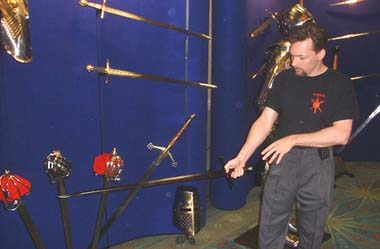 Museum
Replicas Limited had a nice set up, and the largest, with a few new pieces
on hand that were impressive. They seem to finally have gotten it right
for these models at least. Chief designer Bruce Brookheart, a particularly
knowledgeable person on swords, was very proud of some of his results. Museum
Replicas Limited had a nice set up, and the largest, with a few new pieces
on hand that were impressive. They seem to finally have gotten it right
for these models at least. Chief designer Bruce Brookheart, a particularly
knowledgeable person on swords, was very proud of some of his results.
I was certainly convinced by the heft and balance on several, such as
the blackened "High Renaissance Sword" with its raised riser.
Why they don't make a rapier with this kind of cross section perplexes
me to no end?
Their Towton sword was also good, but the Arbedo sword felt splendid.
It's exactly a classic "bastard sword". Good weight, good hilt,
and very stiff. Some of their fantasy pieces, and Lord of the Rings line
were also very nice, but it's odd when they can make their imaginary swords
feel better and seem to handle better than most all of their supposed
historical models.
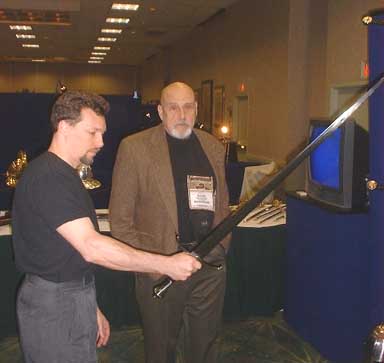 Bruce
confided in me some of the difficulties of getting his designs from drawing
board to prototype to finished production. He assured me MRL is committed
to making changes to improve still further. I do wish this to be true.
But I told him in honesty that it was something I have heard for several
years now from many individuals, but the results are still too hit and
miss, as the contrasting mixture of very nice pieces with less impressive
ones showed. I told him in all honesty there are MRL pieces I recommend
if asked, and there are ones that in good faith I could not. Why this
was the case, was something I left Bruce to ponder. As more or less the
leader of off-the-shelf swords, their market strategies are a mystery. Bruce
confided in me some of the difficulties of getting his designs from drawing
board to prototype to finished production. He assured me MRL is committed
to making changes to improve still further. I do wish this to be true.
But I told him in honesty that it was something I have heard for several
years now from many individuals, but the results are still too hit and
miss, as the contrasting mixture of very nice pieces with less impressive
ones showed. I told him in all honesty there are MRL pieces I recommend
if asked, and there are ones that in good faith I could not. Why this
was the case, was something I left Bruce to ponder. As more or less the
leader of off-the-shelf swords, their market strategies are a mystery.
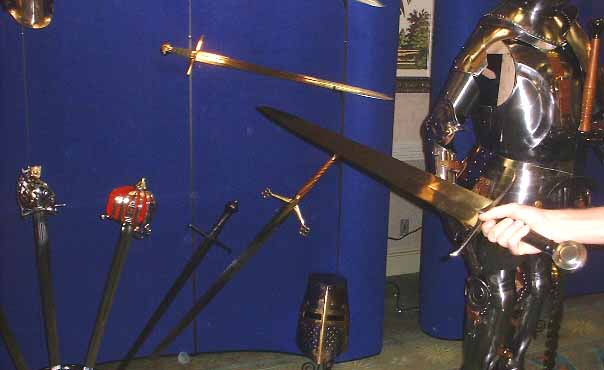
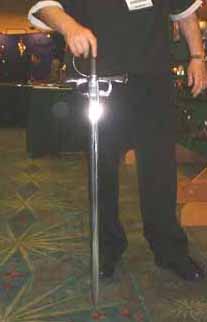 I
also talked some with the cheerful Bob Miller of Pro Cut and was happy
to see several of their pieces had improved noticeably from the year earlier.
Pro Cut offers less expensive pieces that are more historically "inspired"
than historically accurate, but for a simple first time sword at lower
cost, they reach a niche market worth filling. I
also talked some with the cheerful Bob Miller of Pro Cut and was happy
to see several of their pieces had improved noticeably from the year earlier.
Pro Cut offers less expensive pieces that are more historically "inspired"
than historically accurate, but for a simple first time sword at lower
cost, they reach a niche market worth filling.
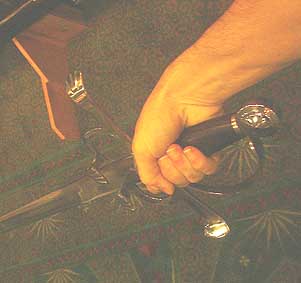 Bob
showed me a cut & thrust style 16th century sword that was not bad
at all, with a good weight, and just a little rough around the edges,
but at a very low cost to consumers that would make it a reasonable "banger"
for learning steel on steel play. There certainly are a dearth of this
model available. Bob
showed me a cut & thrust style 16th century sword that was not bad
at all, with a good weight, and just a little rough around the edges,
but at a very low cost to consumers that would make it a reasonable "banger"
for learning steel on steel play. There certainly are a dearth of this
model available.
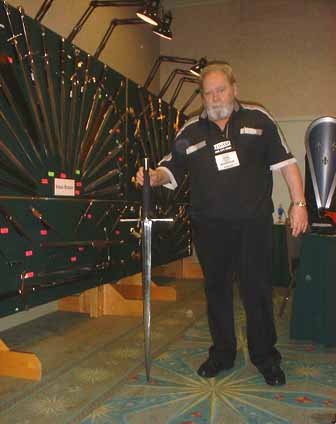 He
also had a longsword and short sword that was similar in quality and price.
His spadone, or tapered bastard sword, was particularly interestsing,
in that it was a very simple no frills weapon with a decently rigid blade
and good weight but very low cost. Not bad at all for beginners or theatrical
fighters. One piece of advice they need to follow however, is that may
of their handles on other pieces were round rather than the proper flattened
oval or rectangular and tapered shape. Round handles on cutting swords,
especially those that are "fat" in the middle, cause the edge
to turn in the hands when cutting. Bob seems to be genuinely committed
to improving his lines and meeting the needs of various sword aficionados,
and for that I wish him the best. Pro Cut genuinely seems to want to improve. He
also had a longsword and short sword that was similar in quality and price.
His spadone, or tapered bastard sword, was particularly interestsing,
in that it was a very simple no frills weapon with a decently rigid blade
and good weight but very low cost. Not bad at all for beginners or theatrical
fighters. One piece of advice they need to follow however, is that may
of their handles on other pieces were round rather than the proper flattened
oval or rectangular and tapered shape. Round handles on cutting swords,
especially those that are "fat" in the middle, cause the edge
to turn in the hands when cutting. Bob seems to be genuinely committed
to improving his lines and meeting the needs of various sword aficionados,
and for that I wish him the best. Pro Cut genuinely seems to want to improve.
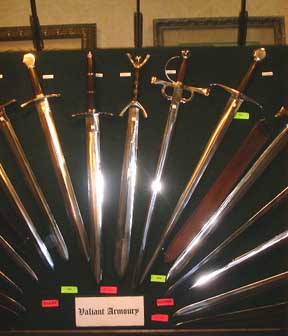 After
talking to several people, I learned another interesting piece of information
when it comes to why makers so often fail to produce decent combat ready
weapons with good blades and hilts: the sword makers make what they know
how to make. They simply don't know that they don't know. And their customers
don't know the difference either. The large sword makers won't change
their methods of manufacturing either even if they do learn how to make
better products unless it's in their economic interest to do so -meaning,
another competitor starts doing it first and the change results in increased
sales. So, for these companies at least, to make better weapons they have
to decide it's profitable for them to do it on their own. Where does that
leave us, the consumers and sword fans? It puts us back at the same place:
for the most part we have to buy what's available and have to pool our
collective power to communicate what to makers it is we want and need.
Again, it all comes back to an educated consumer who knows good product
from bad. After
talking to several people, I learned another interesting piece of information
when it comes to why makers so often fail to produce decent combat ready
weapons with good blades and hilts: the sword makers make what they know
how to make. They simply don't know that they don't know. And their customers
don't know the difference either. The large sword makers won't change
their methods of manufacturing either even if they do learn how to make
better products unless it's in their economic interest to do so -meaning,
another competitor starts doing it first and the change results in increased
sales. So, for these companies at least, to make better weapons they have
to decide it's profitable for them to do it on their own. Where does that
leave us, the consumers and sword fans? It puts us back at the same place:
for the most part we have to buy what's available and have to pool our
collective power to communicate what to makers it is we want and need.
Again, it all comes back to an educated consumer who knows good product
from bad.
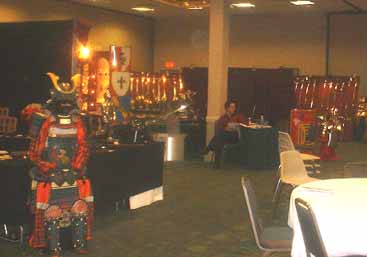 There
are always interesting things I learn at these events and it seems the
real value in who you talk to more often than in how the swords themselves
look and feel. In a bit of industry gossip for instance, one anonymous
person revealed to me that a noted maker was producing inferior rapiers
not because they didn't know any better, and not because their customers
wanted the weapons that way, but because the person themselves "liked
the rapiers" that way, that they "felt" the rapiers should
be a certain way because it favored how they like to play with them (!).
It certainly explained a lot of things to me about these make of rapiers,
and answered a lot of questions as to why we in the historical fencing
community have to keep banging our heads against the wall to influence
makers in to producing better swords. I think this is true for more than
just that one maker. There
are always interesting things I learn at these events and it seems the
real value in who you talk to more often than in how the swords themselves
look and feel. In a bit of industry gossip for instance, one anonymous
person revealed to me that a noted maker was producing inferior rapiers
not because they didn't know any better, and not because their customers
wanted the weapons that way, but because the person themselves "liked
the rapiers" that way, that they "felt" the rapiers should
be a certain way because it favored how they like to play with them (!).
It certainly explained a lot of things to me about these make of rapiers,
and answered a lot of questions as to why we in the historical fencing
community have to keep banging our heads against the wall to influence
makers in to producing better swords. I think this is true for more than
just that one maker.
Over all, I'd say the weapons most in need of improvement were without
question the rapiers. Of all the rapiers I handled, only one of them was
anywhere near historically accurate. I was very surprised at the wobbly
whippiness of the blades and the flimsy hilts or disproportional sizes.
The weapons most absent were simple early 16th century cut & thrust
or side-swords. Those with an interest in Roman or Greek periods should
be happy at the range of items coming out.
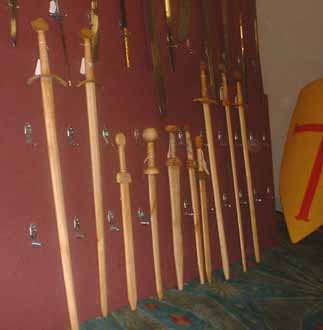 One
observation worth mentioning, is that it seems a good half of the items
on display and in catalogs were simply copies of another company's offerings,
so that for instance, they almost all make their own "version"
of a gothic arming sword or a particular swept-hilt rapier…but in
each case it's a copy of a copy of a copy and one starts to wonder who,
if any, is following the actual dimensions of the original piece in their
reproduction!? One
observation worth mentioning, is that it seems a good half of the items
on display and in catalogs were simply copies of another company's offerings,
so that for instance, they almost all make their own "version"
of a gothic arming sword or a particular swept-hilt rapier…but in
each case it's a copy of a copy of a copy and one starts to wonder who,
if any, is following the actual dimensions of the original piece in their
reproduction!?
The Toledano group, makers of decorative wall-hangers, expressed interest
in entering the replica market in the future. It will be interesting to
see what they offer. The impression I got overall at the show was that
there is still considerable business growth and plans for wider products
lines, but that the fantasy market was growing more than the historical
one. Funny, that.
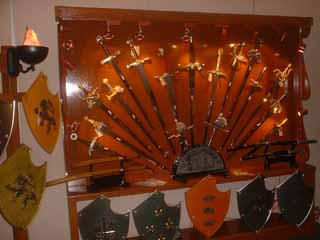
|

